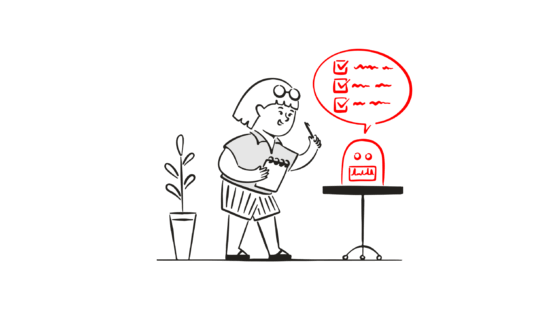Written communication is going through a renaissance of sorts. With the rise of remote work, the ability to express thoughts in a clear and organized manner is in high demand. But while asynchronous communication these days is mostly about chat, emails and texts, there’s another writing skill you should master — how to write a memo.
Memos (memorandums for short) aren’t only a domain of high-profile CEOs. They’re a great, universal tool to build rapport with your team, improve team alignment and cultivate a culture of integrity and transparency. And yeah, they can make you a better writer too.
💡 Before you start… This article is part of our series on effective remote communication. Be sure to check other articles in the series when you’re done reading:
- 💬 Synchronous vs. Asynchronous Communication
- 🤬 Overcome Poor Communication in a Distributed Team
- 📹 The Evolution of Video Conferencing
- 🤝 Remote Mentoring and Team Onboarding
📝 What Is a Memo?
“Memos are brief printed documents traditionally used for routine, day-to-day communication within organizations (…) They accomplish their goals by informing the reader about new information like policy changes, price increases, or by persuading the reader to take an action, such as attend a meeting, or change a current production procedure.”
Purdue College of Liberal Arts, OWL
A memo is an essential communication medium used by businesses and organizations across the board. It’s a more (or less) formal type of document that’s usually unidirectional in a sense that involves one sender and many recipients.
To give you a more visual example, take a look at the opening lines of Jeffrey Katzenberg’s memo on the condition of Disney’s business back in the early ‘90s. 👇
Jeffrey Katzenberg’s memo addressing Disney’s
business and the movie industry in the early ‘90s.
While memos can often run several or dozens of pages long, they do so with sharp focus and efficiency of expression. The best memos are explicit, have a well-thought-out structure and get to the point right from the start.
As an “efficient” medium of expression, memorandums are a staple in military communication. As noted by LaShunda Wilkison who specializes in copywriting for the army personnel:
💬 “The ability to write a professional Army memo is a necessity for any service member. The Army sets high standards and provides specific guidelines for non-ambiguous, clear writing in Army Regulation 25-50, “Preparing and Managing Correspondence.”
In terms of the structure, memorandums are pretty straightforward. If you know how to compose an email, you won’t have any problems with grasping how to write a memo.
Purdue’s OWL(1) suggests breaking down your document into the following “segments”:
- ⚙️ Heading. Similarly to email or snail mail, the heading includes “To,” “From,” “Date” and “Subject” lines. It tells you who wrote the memo, who it’s addressed to and what it’s all about, e.g. “Change in Operation Hours”
- 🏁 Opening. The opening paragraph of a memo clearly states the purpose of the document and briefly introduces the readers to the story/issue
- ✅ Task. The task segment discusses what actions have already been taken in response to the situation. For instance: “Our R&D is already running additional tests (…)”
- 🗣 Discussion. This is the body of a memo. Every bit of research, findings, thoughts, arguments and observations goes in here
- 📑 Summary. Memo summaries are recommended for documents that are longer than one page. You can think of them as “key takeaways”
- 👋 Closing. The closing of a memo is where you discuss the specific outcome you expect and the actions the recipients should take. It’s like the good ol’ call-to-action (CTA)
- 🔗 Attachments. Finally, the attachments segment includes collaterals like charts, links, external resources and statistics you used and referred to throughout the document
✅ What Is a Memo Used For?
Regardless if you’re part of a co-located or distributed team, the key use of memos boils down to formal, internal communication. You can write a memorandum to either inform your team or company about something or elicit a specific action.
Here are some typical use cases:
Provide Updates on Project Progress
Are things going as planned? Is the project on track? Given the current progress, is the original deadline still within reach? Memos can also be a great way to motivate the rest of the team to keep up the pace.
And speaking of motivation… here’s an example of a 10-page memo sent to Microsoft’s applications developers and testers in 1989. 👇
Notify About Upcoming Events
You can pen a memo to announce important company events like:
- 👾 Coding bootcamps
- 🤝 Annual meetups
- 🏝 Company retreats
- 🥳 Festivals and holidays
Unlike emails or chat messages, memos are formal documents. And that alone makes them very effective at eliciting attention, preparation and attendance.
Announce Internal Policy Changes
Memos are perfect for addressing critical changes to internal company policies and procedures. Does your IT department want all WFH employees to use a VPN? All you have to do is send out a memo to let your team know why it’s important and what they should do to comply.
A 2013 memo by Jackie Reses putting an
end to work from home at Yahoo.
Address Specific Issues
A memo is especially well-suited for discussing what’s happening in and around the business, especially when things go south.
- 💸 Cash flow problems
- 📉 Budget cuts
- 🔁 HR rotations
- 🔌 System outages
As a formal document, memorandums should detail how the situation is being handled, how it will affect the staff and what they can do to help.
Set the Stage for Calls and Video Conferences
Since memos dig deep into the issues they discuss, they’re perfect for briefing the team before company or team-wide calls and video conferences. A memorandum can even include a meeting agenda or a list of topics that’ll be discussed during the meeting.
Send Out Gentle Reminders
Want to make sure works gets done on time? Don’t want your emails and chat messages to get lost in the crowd? Type a memo to make sure the important stuff is always in focus.
For instance, you can remind your team to:
- 🔴 Log out of company systems when they finish work at home
- 💾 Save all documents before ending a session
- 🔔 Notify the rest of the team when they’re done editing a document
- 🤫 Keeping offtopic out of the team chat
Bill Gate’s famous 1995 memo reminding Microsoft’s executives
that the Internet is the company’s No. 1 priority.
While memos are technically internal documents, history has shown that they do surface and reach the public more often than not. For that reason, it’s probably not the best idea to include any sensitive information that could damage the reputation of the team or company.
⚡️ How to Write a Memo: 6 Practical Tips
As you can see, memos are pretty powerful stuff. They’re not as easy to turn out as a quick chat message or an email, but they’re definitely way more effective (and satisfying).
One finely crafted memorandum that’s taken days or weeks to write, edit and polish can drive significant change in any type of organization.
So, how do you write a killer memo for your distributed team?
1. Consider Your Options
Of course, you don’t want to email memos for every video meetup or misc event coming your team’s way. So, before you start memo writing, ask yourself the following questions:
- Is the memo format the right way to communicate in this situation?
- Wouldn’t a short email or video meetup suffice?
- Do I have enough intel on the issue?
- Am I trying to avoid direct confrontation?
2. Be Selective About What You Include
Memos are all about making an impact. That’s why you should focus on one essential piece of information per document. If you try to include too much *important* stuff, chances are people won’t know what they should pay attention to. When everything is important, nothing is.
- State the purpose of the document in the first paragraph
- Keep the subject in focus across the entire text
- Follow the rule of “one memo, one idea”
- Build your memo on strong, relevant arguments
3. Use Appropriate Language
If you want to flex your vocabulary, memos are not the place to do that. Since memos address mixed groups of employees that come from different teams and departments, you should adjust the language so they’re accessible to everyone involved.
- Put clarity and accessibility first
- Cut jargon and technical terms
- Use active sentence construction
- Adjust the tone to match your audience
- Keep your memo format short and to the point
4. Think About The Structure
The difficulty and appeal of memos clash in structure. One the one hand, you want to write a document that digs deep into the issue and discusses it in the most complete way. On the other, planning out all the arguments and bits of research can be a tedious exercise.
Here are a handful of pointers that’ll get you started:
- Present your arguments from the strongest to the weakest
- Describe the subject top-down, increasing granularity as you go
- Use headlines and subheadings to help readers navigate the memo
- If you expect a specific action in response, always include a call-to-action (CTA)
5. Proofread, Rinse, Repeat
Memo writing requires time and intellectual investment. If you want to get the best bang for your effort, be sure to fix any typos and style inconsistencies before hitting send.
- Don’t skip proofreading and editing
- When done, proofread again, rinse and repeat
- Offer an early sneak peek for feedback and suggestions
- If you don’t enjoy reading it, your employees won’t enjoy it either
6. Experiment With Formatting
Formal? Sure. Boring? Not really.
While most memos mean official company business, they don’t have to bore your readers with solid blocks of text. We’re not saying you have to stuff the document full of *interesting* charts, images or whatnot, but…
A little styling can get your memo a long way:
- Highlights key information with colors
- Experiment with special characters ✏
- Bold, underline and italicize where appropriate
- Explore different types of heads and subheads (H1, H2, H3)
☝️ Why Should You Care about Memos in 2022?
The Process
Let’s face it. Although we live in the *communication age*, effective, professional communication has become somewhat of a unicorn. Sure, we’ve become particularly skilled at instant messaging, rapid email exchanges and texting. But writing in-depth, well-structured documents isn’t exactly the smash hit of the modern workplace.
Now, as more businesses are adopting a fully distributed model, asynchronous written communication becomes a staple. And, it turns out, writing memos is one of the best exercises to flex those communication muscles.
According to the man himself, Amazon’s CEO Jeff Bezos:
“The reason writing a ‘good’ four page memo is harder than ‘writing’ a 20-page PowerPoint is because the narrative structure of a good memo forces better thought and better understanding of what’s more important than what.”
While Bezos’ observation comes from a 2004 email he sent to the Amazon team, it’s even more relevant than it was back then. Unlike any other method of internal communication, writing memos requires a serious investment of time and attention.
Typing memorandums for your distributed team is the best way to master the art of effective, professional communication. It compels you, as a writer, to go deep under the surface of the issue, organize your thoughts, focus on the audience and find out what’s in for them.
Transparency and Trust
Memos have the substance no other medium, including chat or email, can carry. When you take your time and send out a memorandum, you tell your team, “Hey, I have some *really* important news for you.”
But that’s not all.
Memos are a footprint of a significant change, event, or issue unfolding within the team or company. It’s a written record people can refer to in the future. And since most memos are formal documents, they keep your *accountability* as the author high.
Memos can help you build rapport with your distributed team. They show that you care about the quality and quantity of communication, are transparent about what’s happening at the company and trust the rest of the team with critical business intel.
Open Conversation
Unlike direct messages (DMs) where two employees communicate with each other, memos usually have multiple recipients. They involve everybody in the exchange of information, which makes them particularly useful for encouraging open conversations.
This is key in distributed teams that tend to fall into communication silos. Many remoters don’t have the incentive to spontaneously reach out to their colleagues. Communication happens out of necessity, either to talk over project details or solve problems.
While memos are technically unidirectional, they can encourage all members of your distributed team to pick up the discussion. They create a culture of visibility where open, transparent communication is a norm rather than an exception.
🐑 How to Write a Memo with Taskade
Learning how to write a memo for your team takes time and perseverance. The good news is, you don’t need a stack of memo writing tools to get the job done. Taskade comes with a ton of great features that will help you create a true masterpiece in no time.
Use a Writing Template
Don’t know how to structure your memo? Not sure where to start? Taskade comes with hundreds of editable templates that’ll let you kick off any kind of writing project. You can pick up one of the *free* templates we have onboard or create your own.
Here’s one for your first memo. 👇
In case that Hemingway spirit moves ya, go ahead and take a peek at other writing templates too:
- ✍️ Boost Your Writing Productivity
- 🎯 Write a Marketing Plan
- 💡 Create a Bullet Journal
- ✏️ Take Great Meeting Notes
- 🎭 Draft a Team Review
Create a Digital Bulletin Board
Did you know that you don’t have to use email to send memos to your distributed team? Instead, you can turn Taskade’s Workspaces and Subspaces into a digital bulletin board.
Just like this one. 👇
All you have to do is create a Project space, pick a template, fill it in and put it out there for the whole team to see. Once you’re done, you can share access to the memo and set User Roles so only you can edit it.
You may also want to invite some team members for a sneak peek and let them contribute feedback and suggestions directly on the document (with Editor privileges).
Make Your Memos Look Good
Remember what we said earlier about experimenting with formatting?
Taskade lets you get really creative with your memos. You can apply colors, highlight key information, add images, set bullet list style and format the text any way you want.
Set Expiration Dates
There are many types of memos — some are written in a response to a specific situation. Others address ad-hoc changes in policies and procedures. Make sure that your employees know when these changes come into effect and when they no longer apply.
You can use Taskade scheduling features to:
- ⏰ Set start and end dates
- 📈 Establish milestones and goals
- 🗓 Visualize memos on a timeline
- 🔎 Display memos as an agenda
- And more…
🧙♂️ Effective Written Communication Is a Superpower
The ability to write, something we often take for granted, is like a muscle. The more you use it, the stronger it gets. While texting and churning out emails won’t make you break a sweat, learning how to write a memo (and do that right) will keep those gears turning. ⚙️
But that’s not all.
(Remote) office memos are perfect for balancing autonomy and team alignment. On the one hand, they have the priority and importance no other medium has. On the other, memos are not as pervasive as emails and leave your distributed team some decision-making capacity.
In a way, learning how to write a memo, or any other business document for that matter, can become your remote work superpower! ⚡️
🤖 Custom AI Agents: Use custom AI agents to automate your workflows, from structuring and researching to generating and editing content.
🪄 AI Generator: Outline projects and business writing, from executive summaries to reports, all based on natural-language descriptions.
✏️ AI Assistant: Write and refine business documents. The assistant can suggest edits, improve language, and refine arguments.
🗂️ AI Prompt Templates Library: Explore a collection of AI prompt templates to kick off business and personal writing projects.
And much more…



 AI Predictive Project Management for Enhanced Productivity in 2024
AI Predictive Project Management for Enhanced Productivity in 2024  Transform Your Tasks Into Visual Workflows With Generative AI
Transform Your Tasks Into Visual Workflows With Generative AI  The 9 Best AI Project Management Templates for 2024
The 9 Best AI Project Management Templates for 2024  How to Write a Standard Operating Procedure (SOP) (+Template)
How to Write a Standard Operating Procedure (SOP) (+Template)  14 Best Task Management Software and Tools for 2024
14 Best Task Management Software and Tools for 2024  The 6 Best Trello Alternatives in 2024
The 6 Best Trello Alternatives in 2024